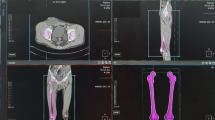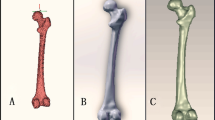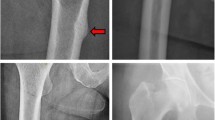Abstract
Summary
Atypical femoral fractures (AFFs) are categorized as low-energy fractures of the femoral shaft or subtrochanteric region. The use of computed tomography-based finite element analysis demonstrated that the femoral weakest point against tensile stress coincided with AFF location, which was determined by the lower limb axis and femoral bowing.
Introduction
This study aimed to assess the relationship between the femoral weakest point against tensile stress and the lower limb axis and geometry, including femoral bowing, using a computed tomography (CT)-based finite element analysis (FEA) model.
Methods
We retrospectively reviewed 19 patients with AFFs and analyzed their CT images of the contralateral intact femur. We performed FEA to find the maximum principal stress (MPS) and maximal tensile stress loading area (femoral weakest point, FWP) of each patient and matched the FWP with the real location of AFF. We applied mechanical axes differently, as neutral, varus, and valgus, in the FEA model, when we analyzed the change in MPS and FWP based on lower limb alignment. We compared the degree of agreement between the real fracture location and FWP before and after knee mechanical axis adjustment.
Results
The average participant age was 75.9 (range, 61–87) years, and all participants were women. In the 19 patients included, we observed 20 and 7 shaft and subtrochanteric AFFs, respectively. The average mechanical axis at the knee joint level was 22.6 mm (range, 0–70 mm) of the varus. All the patients showed an increasing trend of MPS and a distal movement of FWP when the mechanical axis of the knee was applied from the valgus to varus alignment. The root mean square errors between the FWP and real fracture location were 14.58% and 10.87% before and after adjustment, respectively, implying that the degree of agreement was better in patients who underwent mechanical adjustment.
Conclusion
The use of CT/FEA demonstrated that the FWP against tensile stress coincided with AFF location, which was determined by the lower limb axis and femoral bowing.






Similar content being viewed by others
Data availability
Data cannot be shared publicly because it contains potentially identifying information of each patient. Data are available from the Asan Medical Center Institutional Data Access/Ethics Committee (contact via Asan Medical Center Institutional Review Board, Convergence Innovation Bldg. 88, Olympic-ro 43-gil, Songpa-gu, Seoul, Republic of Korea. Website link, http://eirb.amc.seoul.kr/; E-mail, irb@amc.seoul.kr; Phone, + 82–2-3010–7165) for researchers who meet the criteria for access to confidential data.
Code availability
Not applicable.
References
Shane E, Burr D, Abrahamsen B et al (2014) Atypical subtrochanteric and diaphyseal femoral fractures: second report of a task force of the American Society for Bone and Mineral Research. J Bone Miner Res 29:1–23
Odvina CV, Zerwekh JE, Rao DS, Maalouf N, Gottschalk FA, Pak CY (2005) Severely suppressed bone turnover: a potential complication of alendronate therapy. J Clin Endocrinol Metab 90:1294–1301
Haider IT, Schneider PS, Edwards WB (2019) The role of lower-limb geometry in the pathophysiology of atypical femoral fracture. Curr Osteoporos Rep 17:281–290
Kim K-k, Park Y-w, Kim T-h, Seo K-d (2020) Atypical femoral neck fracture after prolonged bisphosphonate therapy. J Pathol Translat Med 54:346–350
Buitendijk SKC, van de Laarschot DM, Smits AAA, Koromani F, Rivadeneira F, Beck TJ, Zillikens MC (2019) Trabecular bone score and hip structural analysis in patients with atypical femur fractures. J Clin Densitom 22:257–265
Lim SJ, Yeo I, Yoon PW, Yoo JJ, Rhyu KH, Han SB, Lee WS, Song JH, Min BW, Park YS (2018) Incidence, risk factors, and fracture healing of atypical femoral fractures: a multicenter case-control study. Osteoporos Int 29:2427–2435
Morin SN, Wall M, Belzile EL, Godbout B, Moser TP, Michou L, Ste-Marie LG, de Guise JA, Rahme E, Brown JP (2016) Assessment of femur geometrical parameters using EOS imaging technology in patients with atypical femur fractures; preliminary results. Bone 83:184–189
Oh Y, Wakabayashi Y, Kurosa Y, Ishizuki M, Okawa A (2014) Stress fracture of the bowed femoral shaft is another cause of atypical femoral fracture in elderly Japanese: a case series. J Orthop Sci 19:579–586
Sasaki S, Miyakoshi N, Hongo M, Kasukawa Y, Shimada Y (2012) Low-energy diaphyseal femoral fractures associated with bisphosphonate use and severe curved femur: a case series. J Bone Miner Metab 30:561–567
Haider IT, Schneider P, Michalski A, Edwards WB (2018) Influence of geometry on proximal femoral shaft strains: implications for atypical femoral fracture. Bone 110:295–303
Oh Y, Fujita K, Wakabayashi Y, Kurosa Y, Okawa A (2017) Location of atypical femoral fracture can be determined by tensile stress distribution influenced by femoral bowing and neck-shaft angle: a CT-based nonlinear finite element analysis model for the assessment of femoral shaft loading stress. Injury 48:2736–2743
Oh Y, Wakabayashi Y, Kurosa Y, Fujita K, Okawa A (2014) Potential pathogenic mechanism for stress fractures of the bowed femoral shaft in the elderly: mechanical analysis by the CT-based finite element method. Injury 45:1764–1771
Park YC, Song HK, Zheng XL, Yang KH (2017) Intramedullary nailing for atypical femoral fracture with excessive anterolateral bowing. J Bone Joint Surg Am 99:726–735
Mosleh H, Rouhi G, Ghouchani A, Bagheri N (2020) Prediction of fracture risk of a distal femur reconstructed with bone cement: QCSRA, FEA, and in-vitro cadaver tests. Phys Engineer Sci Med 43:269–277
Heiner AD (2008) Structural properties of fourth-generation composite femurs and tibias. J Biomech 41:3282–3284
Lee S-J, Lee H-J, Kim J-I, Oh K-J (2011) Measurement of the weight-bearing standing coronal and sagittal axial alignment of lower extremity in young Korean adults. J Korean Orthop Assoc 46:191–199
Polgár K, Gill HS, Viceconti M, Murray DW, O’Connor JJ (2003) Strain distribution within the human femur due to physiological and simplified loading: finite element analysis using the muscle standardized femur model. Proc Inst Mech Engineer H 217:173–189
Ha S, Lee JJ (2018) A comparison of the accuracy of different single plasma sample methods for measuring glomerular filtration rate using 51Cr-EDTA in children. Nucl Med Molec Imag 52:293–302
Kim JW, Kim JJ, Byun YS, Shon OJ, Oh HK, Park KC, Kim JW, Oh CW (2017) Factors affecting fracture location in atypical femoral fractures: a cross-sectional study with 147 patients. Injury 48:1570–1574
Hyodo K, Nishino T, Kamada H, Nozawa D, Mishima H, Yamazaki M (2017) Location of fractures and the characteristics of patients with atypical femoral fractures: analyses of 38 Japanese cases. J Bone Miner Metab 35:209–214
Chen LP, Chang TK, Huang TY, Kwok TG, Lu YC (2014) The correlation between lateral bowing angle of the femur and the location of atypical femur fractures. Calcif Tissue Int 95:240–247
Saita Y, Ishijima M, Mogami A et al (2014) The fracture sites of atypical femoral fractures are associated with the weight-bearing lower limb alignment. Bone 66:105–110
Jung IJ, Choi EJ, Lee BG, Kim JW (2021) Population-based, three-dimensional analysis of age- and sex-related femur shaft geometry differences. Osteopor Intl. Online ahead of print.
Kim JW, Kim H, Oh CW, et al. (2017) Surgical outcomes of intramedullary nailing for diaphyseal atypical femur fractures: is it safe to modify a nail entry in bowed femur? Arch Orthop Trauma Surg
Shon OJ, Yoon JY, Kim JW (2020) Clinical outcomes of using contralateral-side laterally bent intramedullary nails in atypical femur fractures with femoral bowing. Arch Orthop Trauma Surg 141:1291–1296
McKenna MJ, McKiernan FE, McGowan B, Silke C, Bennett K, van der Kamp S, Ward P, Hurson C, Heffernan E (2017) Identifying incomplete atypical femoral fractures with single-energy absorptiometry: declining prevalence. J Endocr Soc 1:211–220
Funding
This work was supported by the National Research Foundation of Korea (NRF) grant funded by the Korea government (MSIT) (2021R1A2C1012972).
Author information
Authors and Affiliations
Corresponding author
Ethics declarations
Ethics approval
This study was approved by the Institutional Review Board of Asan Medical Center and waiver was received for the need to provide written informed consent (IRB No. 2019–1568).
Consent to participate
For this type of study, formal consent is not required.
Consent for publication
Not applicable.
Statement of human rights
The manuscript does not contain clinical studies or patient data. For this type of study, formal consent is not required.
Conflicts of interest
None.
Additional information
Publisher's Note
Springer Nature remains neutral with regard to jurisdictional claims in published maps and institutional affiliations.
Supplementary Information
Below is the link to the electronic supplementary material.
Rights and permissions
About this article
Cite this article
Hwang, D., Kim, CH., Lee, Y. et al. Association of atypical femoral fracture location and lower limb mechanical axis: a computed tomography-based finite element analysis. Osteoporos Int 33, 1285–1293 (2022). https://doi.org/10.1007/s00198-021-06173-1
Received:
Accepted:
Published:
Issue Date:
DOI: https://doi.org/10.1007/s00198-021-06173-1




